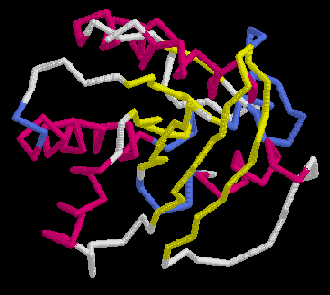TABLE OF CONTENTS
Ras Activation, Mutation, and Research

| Figure 1- The back bone of the small G protein Ras. Typical Ras molecules contain approximately 190 residues (Boguski et al., 1993). This image is used with permission from Dr. Raymond Mosteller at the University of Southern California Keck School of Medicine (http://www-hsc.usc.edu/~rmostell/). |
OVERVIEW
The small G protein Ras regulates many aspects of cell growth and differentiation and for this reason has been under intense study in the past decade. In fact recent discoveries link the Ras superfamily to tumorigenicicy (Boguski et al., 1993). Ras is found in two states: the active state when GTP is bound and the inactive state, when GDP is bound. Tumorigenicity is prevellant when mutations allow Ras to remain activated state, thus relaying a signal for cell growth (Bourne et al., 1990).
